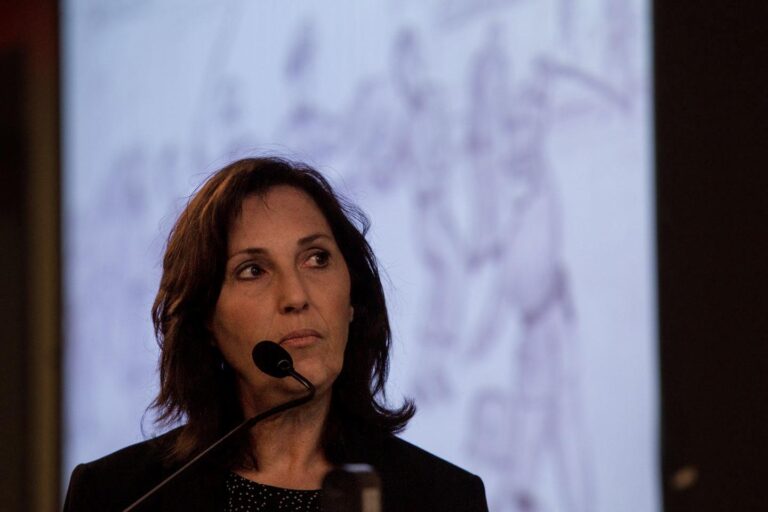Anna Salton Eisen grew up with parents who survived the atrocities of the Holocaust but never spoke about it.
She was about 7 when she found two small watercolors depicting the brutalities of Nazi Germany and signed “L. Salzman” — a name she didn’t know — and began piecing together the truth.
“When I would ask my father about his background or about his family, he would get a look of anguish. And he would say, ‘let’s not talk about it.’”
Antisemitism reached an all-time high with more than 2,700 reports of harassment, vandalism and assault across the nation in 2021, according to the Anti-Defamation League, which
continues to track incidents
from 2022 and 2023.
Some of those acts — threats and protests by Holocaust deniers and flyers left near homes with messages of hate — have unfolded in San Antonio and other Texas cities. Last year, a gunman held four people hostage in a North Texas synagogue and was killed by federal authorities. The 10-hour standoff stirred horrific memories of a 2018 shooting at a Pittsburgh synagogue that claimed 11 lives.
Texas was one of the first states to recognize a need for education on the Holocaust, antisemitism and genocide that has occurred in Cambodia, Darfur and other parts of the world.
Four years ago, the Legislature created
Texas Holocaust Remembrance Week, held on the anniversary of the liberation of prisoners at Auschwitz on Jan. 27, 1945.
In observance, the San Antonio Public Library and the Holocaust Memorial Museum hosted four scholars, including Eisen, to speak at their annual “Learn and Remember” series.
Eisen was in her 30s and had moved to North Texas, where she studied the Holocaust, when she finally confronted her father, who had changed his name from Lucjan Salzman to George Lucius Salton.
Salton, who grew up in Poland, came to the United States after the war, joined the Army and became a U.S. citizen.
Together, they wrote “The 23rd Psalm: A Holocaust Memoir,” published in 2004, about his experience overcoming indignities, beatings and starvation. He witnessed countless atrocities in 10 different camps from age 14 to 17. He died in 2016.
Eisen is a founding member of Congregation Beth Israel in Colleyville, where a frightening standoff occurred last year. She shared her story in “Pillar of Salt: A Daughter’s Life in the Shadow of the Holocaust,” co-written with her son Aaron Eisen and published in May.
“Since I first became involved in learning about the Holocaust more than 30 years ago, I have been speaking in schools and doing everything I can to preserve the truth in history and fight hate,” Eisen said.
“When my father was in the sixth grade, he was called a dirty Jew and sent home from school. And when my son Aaron here was in sixth grade, he was called a dirty Jew in Texas.”
The family’s faith in humanity was reaffirmed again when her son won an essay contest on the Holocaust.
“In some ways … the Holocaust has no bottom,” she said. “It is a history of inter-generational trauma and pain and loss. But it is our story. And if we do not protect it and keep it and learn and put it in the hands of other people, then we have to deal with all the distortion and denial that is going on now that we must fight.”
Bloodlust
Nazi troops were authorized to shoot unarmed civilians for showing “active or passive resistance.”
“‘Shot while attempting to escape’ becomes another euphemism for finishing people off,” said Edward B. Westermann, author and history professor at Texas A&M University-San Antonio.
Translations of letters sent home by German troops reveal how they became hardened. Viennese police official Walter Manner, writing to his wife, admitted his hands shook during his first “special action.”
But on his 10th mass execution, “I calmly and surely shot at the many women, children and infants.” He and fellow policemen made a game of shooting children. He wrote he now knew the meaning of
Blutrausch
— bloodlust.
Karl Kretschmer of the
Schutzstaffel
(SS) shared with his wife that “in Russia, wherever the German soldier is, no Jew remains.” He “needed some time to come to grips with this.”
He later wrote to his wife and children, “People soon get used to the sight of blood but
Blutwurst
(blood sausage) is not very popular round here.”
Konrad Jarausch, a German sergeant who died of typhoid in 1942, questioned the brutalities, writing to his wife a few months before his death, “This is truly the work of the devil.” His son, German history scholar Konrad H. Jarausch, edited the letters for a book, “Reluctant Accomplice.”
But most showed little remorse. Diary entries of SS Dr. Johann Kremer chronicled mass gassings he oversaw at Auschwitz and details of the food he ate: “baked pike…real ground coffee, excellent beer and open sandwiches.”
“So you see this jarring juxtaposition, matter-of-factly talking about the murder of thousands during the day … and how he had a nice cozy evening,” Westermann said.
Remembering their stories
“I want to give a voice back to people it was taken away from,” said Reyna Stovall, a 19-year-old San Antonio sophomore studying human rights at Fordham University in New York City.
“The lessons of the Holocaust are more important today than ever,” she said. “Sadly, I don’t think a lot of younger people have the awareness of the Holocaust that they should.”
Reading “The Book Thief” as a teenager sparked her yearning to learn more about the atrocities. She encouraged her mother, who was adopted, to take a DNA test. They discovered they had Jewish roots.
Freedoms of speech and the press were taken away in Germany in the 1930s, and new laws forced the segregation of Jewish people.
“The Nazis used the term ‘final solution’ as a euphemism for the mass murder they would end up committing,” Stovall said.
Magarete Brady and her Jewish family in the Czech Republic were active in their town until German troops arrived in 1939. Margarete was deported to Ravensbrück, a concentration camp for women, where she was allowed to write home once a month on a pre-printed form.
“I’m happy that you are healthy. I am too,” she wrote to a relative in May 1942.
Her husband was murdered at Auschwitz two months later. Margarete was killed there in October 1942. A daughter, Hana, died there at age 13 in 1944. Their son, George, survived and moved to Canada, where he lived to be 90. A suitcase Hana took when she was deported became the subject of a best-selling children’s book, “Hana’s Suitcase,” by Karen Levine.
“It’s our duty to maintain their stories, to continue to tell them so that people can learn from them and we’re not destined to repeat the mistakes of the past,” Stovall said.
Take a stand
Posters, movies and even children’s books, such as
Der Giftpilz
(The Poisonous Mushroom), portrayed European Jews as deceitful, greedy and dangerous. Some propaganda compared them to rats.
“Virtually all kids in elementary schools would be reading ‘The Poisonous Mushroom,’” said Roger Barnes, retired sociology professor at the University of the Incarnate Word.
Idyllic images of fair, light-haired Aryan families and suppression of music, art and literature dismissed by the Nazis as unpatriotic or impure set the stage for the systematic killing of 6 million Jews and 5 million others, including communists, gay men, the disabled and ethnic minorities.
“The first victims of Nazi brutality and killing were people who were deemed unfit to live … the people that today we would say have suffered from intellectual disabilities,” Barnes said.
He sees propaganda in America today that spews hatred — much of it similar to Nazi Germany, repeating the same messages to give the illusion “that most people agree.” Part of the remedy, says Barnes, is “teaching about sensibilities, sensitivities and ethics.”
“It becomes incumbent upon all people to take a stand against antisemitism,” he said. “There is no neutral ground here. If you don’t protest against antisemitism, you’re in compliance with it.”
“Sometimes this requires us to be brave, to get out of our comfort zone,” he said. “But you’ve only got one life to live. If you’re going to live with some meaning and some passion, then I think this becomes incumbent upon us all.”
shuddleston@express-news.net




